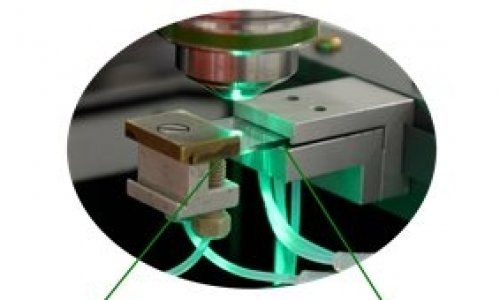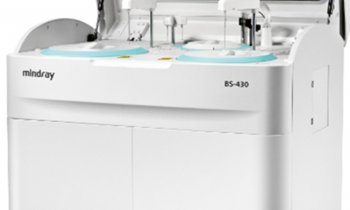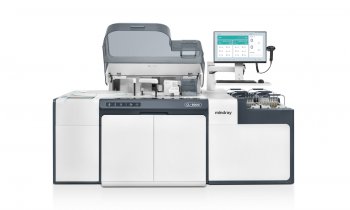Diagnostics
Part II: Iron deficiency and anaemia
Iron deficiency and resulting anaemia cause fatal comorbidities worldwide. Despite this, they are generally underestimated. Professor Lothar Thomas, specialist in laboratory medicine at the Central Laboratory in the Frankfurt/Main University Hospital, is seeking more information about new laboratory parameters for diagnosis and monitoring of iron deficiency and iron substitution therapy. The professor spoke with Dr Wolfgang Hildebrandt, of Siemens Healthcare Diagnostics GmbH, about recent options in laboratory diagnostics.

To initiate targeted therapies the cause and stage of iron deficiency must be identified. Asked to recommend a laboratory strategy for simple iron deficiency, Prof. Thomas advised: ‘In patients with uncomplicated iron deficiency, i.e. without chronic inflammatory diseases, the blood panel including the MCV, MCH, Hb, and the determination of serum ferritin as a marker for iron supply, or the stored iron reserve, is completely sufficient.’
For complicated iron deficiency the situation changes. ‘As soon as there are inflammations, infections, autoimmune diseases, hepatocellular diseases, renal insufficiency, cancers, alcoholism or hypothyreosis, or women taking contraceptives, then ferritin, the acute-phase-protein, is non-specifically increased and cannot be used as an indicator for iron deficiency.
‘Twenty percent of patients with chronic inflammations develop anaemia because of their chronic illnesses (ACD, anaemia of chronic diseases). Therefore, it is highly important to clarify the iron deficiency. The treating physician must then determine whether the patient is free of any chronic inflammations. After all, about fifty percent of patients with iron deficiency suffer from an inflammation. ‘After three months with chronic inflammation, anaemia must always be assumed. If anaemia is suspected, or a chronic inflammation is known, then ferritin, the acute phase protein, does not make much sense. To determine the inflammation, the CRP must be determined alongside the blood panel. Any levels in excess of 5 mg/L mean there is an inflammation.’
Meaningful parameters to diagnose early iron supply limitations
‘It’s important that any iron deficiency be diagnosed in patients very early and before the manifestation of anaemia. This can only be achieved when the actual situations are based not only on the overall cellular level but also in the individual cell itself.
‘The usual parameters of the small blood panel, such as the MCH, MCV or Hb, are summary sizes, which are not suited for a condition analysis of the individual cell. Reticulocytes are better suited because they can only be verified in the blood for a few days after their formation. The cellular parameters CHr (reticular haemoglobin) and %HYPO (percentage of hypochromic erythrocytes) bring us a good bit further.
‘In accordance with guidelines on iron deficiency and iron deficiency anaemia issued by the DGHO – the German Society for Diagnosis and Therapy of Haematologic and Oncologic Diseases – the ADVIA values of < 28 pg CHr and also >10 %HYPO are deemed as proof for an iron deficient erythropoiesis.
‘The large advantage of these parameters is that they are not only independent of chronic inflammatory diseases, but they also show the need for iron much earlier than the MCV, MCH and Hb, namely within a time frame of three to five days (CHr) or a mean time range of 25 days (% HYPO). This is of invaluable importance for monitoring iron substation therapies such as intravenous infusions of ferric carboxymaltose.’
The Thomas Plot
‘The Thomas Plot is a practical aid that helps to interpret complex iron metabolism disorders that is difficult in chronic inflammations. We must assume that in fifty percent of affected patients, the iron requirement is not sufficiently covered due to chronic inflammation caused by increased hepcidin and that, in many patients, an additional loss of iron is created through bleedings caused by the illness.
‘The combination of CHr as an early indicator of the iron requirement and the ferritin index as marker for iron supply enables classification of iron deficiency into four stages. At the beginning and during therapy monitoring, the patient values are arranged into four quadrants, which characterise very different conditions of iron supply or iron need of the erythropoiesis.
‘The value in this is that it allows therapeutic decisions to be made regarding oral/intravenous iron substitution therapy and/or stimulation with rHuEPO, and allows the success of the therapy to be monitored. The plot itself has no significance in patients with thalassemia.’
Medication and diet
‘A CHr value of under 28 pg, or a CHr lower than the MCV, always justify iron therapy, even in patients with inflammation or with normal ferritin levels. In general, out-patients would begin with an oral iron substitution therapy, which lasts several weeks because of the limited enteral absorption rate.
In addition, iron substitution is ineffective based on the limited duodenal iron absorption caused by inflammation and because of the side effects. Many patients complain about stomach intolerance and constipation.
‘In such cases, the intravenous infusion of high-dosed iron carboxymaltose (1,000 mg of the anti-anaemic drug Ferinject of Vifor Pharma), is the substance of choice. This parenteral method has barely any side effects and offers a great advantage compared to oral therapy. The iron deficiency can be balanced within a few days.
‘All women in Switzerland receive an intravenous iron infusion after childbirth. Frequently, high-dosed iron infusions are administered during surgeries, which are known to cause a significant loss of blood, and sometimes for conditioning; this infusion is already administered prior to surgery and then again during surgery.
‘Studies about pre- and post-operative intravenous iron substitution to replace allogenic blood transfusions in patients with pre-surgical iron deficiency are particularly promising. It was possible to achieve good results from primarily intravenous administration combined with erythropoiesis stimulating substances. This not only opens up entirely new perspectives for surgery and transfusion medicine but also new challenges for laboratory diagnostics.’
Intravenous correction
‘For a short while now, it has been known that iron deficiency is a strong risk factor in patients with chronic heart failure (CHI). CHI is a disease characterised by many in-patient stays and an increased mortality. Jankowska EA, et al. [Iron deficiency: an ominous sign in patients with systolic chronic heart failure. Eur Heart J 2010; 31:1872-1880] demonstrated in their prospective study on 546 patients with systolic heart failure that 37 percent of these patients suffered from iron deficiency and only 54 percent of them survived after an observational period of 731 days compared to 67 percent of patients without iron deficiency. CHI patients have a particularly bad outcome, if they already suffer from anaemia with haemoglobin levels of <12 g/dL.
‘After a recent analysis of EVITA-HF [EVIdence Based TreAtment of chronic Heart Failure-Register. Wienbergen H, et al. 2012; 101, (Suppl. 1): V1138], 22.4 percent of 1,278 examined CHI patients already had manifested anaemia. Compared to non-anaemic patients, these show a more than twice as high one-year-mortality. This means nearly every fourth CHI patient with anaemia has passed away after one year.
‘In around 80 percent of these patients, iron deficiency caused the anaemia. This proves clearly that (iron deficiency caused) anaemia in HF patients is not only a marker for high risk but also an independent prognostic factor for the bad clinical outcome.
‘The FAIR-HF study [Ferinject Assessment in patients with IRon deficiency and chronic HF. Anker SD, et al. [Eur J Heart Fail 2009; 11: 1084-1091] proved clearly that the in-vitro administration of iron carboxymaltose (Ferinject, Vifor Pharma) improves symptoms, the capacity for physical stress and quality of life in all HF patients, regardless of whether they were iron deficient or not. This data situation has caused the European Society for Cardiology (ESC) to favour the intravenous correction of iron deficiency with iron carboxymaltose in its current guideline on diagnosis and treatment of heart failure [McMurray JJ, et al. Eur Heart J 2012; 33: 1787-1847].
Inconsistency
‘Well, despite the progressivity of the decision, the ESC recommendation for laboratory diagnostics still remains inconsistent. Serum ferritin, CRP and transferrin saturation – without CHr, %HYPO and without the ferritin index – does not achieve early detection of iron deficient erythropoiesis and it does not allow the success of the iron substitution therapy in CHF patients to be monitored in a timely manner.
The lab’s role in iron deficiency care
‘It’s necessary to estimate progress, i.e. success or failure of such substitution therapies as early as possible, using a suitable diagnostic monitoring tool. Ferritin alone, and the transferrin saturation are not always sufficient because many patients have inflammations that falsify both parameters. It all begins with the clarification that an inflammation is present, the causes of which must also be treated because it affects iron metabolism.
‘The CHr should be checked no later than one week after the iron infusion started; the CHr should have increased at the latest after two weeks (relative increase is significant). If the CHr did not increase, then the iron substitution therapy failed and the cause must be determined. For example, the success of the iron therapy in chronic inflammations of the intestinal tract, which are only expressed in an increased CRP level in about 10 percent of patients, is limited.
‘At the latest, the %HYPO must drop during the fourth week because, under normal conditions, it can be assumed that the reticulocytes are now sufficiently supplied with haemoglobin. If, after some time, a lower CHr is found compared to the (still) normal MCH, then we are dealing again with an early iron deficiency.
‘If both parameters are low then we are talking about the old iron deficiency, because it is older than three months.
‘If the CHr is already normal, but instead the MCH is (still) low, we have a clear indication of a response to the therapy. Such rational diagnosis is uncomplicated and only needs the small blood panel and reticulocytes (CHr). This is also helpful for the transfusion physician when he or she decides whether the pre-operative iron infusion is effective enough to improve the autologous regeneration ability of the patient during peri-operative blood loss, during the therapy period, so the patient could be spared any blood transfusions.’
Conclusion
‘It would be desirable for this contribution, with detailed, innovative knowledge in laboratory diagnostics of iron deficiency and iron deficiency anaemia, to generate some awareness on the subject.’
Iron Deficiency - A strong independent risk factor in CHF
Based on the effectiveness in the treatment of chronic heart failure (CHF), in 2012 the intravenous iron deficiency correction in CHF patients who have iron deficiency as an independent risk factor has been officially approved in the European Society for Cardiology (ESC) guideline.
16.03.2015











